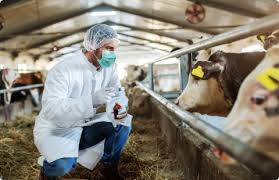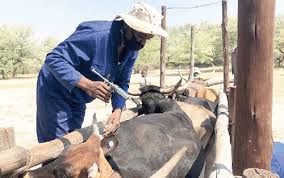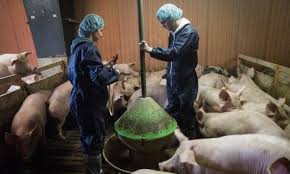This article will address the general signs exhibited by healthy animals, signs of illness or disease, and the general measures of disease prevention on a farm. Since these measures are similar for most livestock, they will be covered collectively in this article.
Health is commonly defined as freedom from disease. Disease, in turn, is any disturbance of normal body processes that negatively impacts an animal.
Such disturbances can be caused by physical injuries, bacteria, viruses, parasites, fungi, poisons, dietetic errors, metabolic disturbances, or hereditary defects. Every effort should be made to support health and avoid diseases.
Read Also: Feijoas: History, Nutrition, Health Benefits and Growing Guide
Signs of Good Health in Livestock

There are various clinical signs an animal attendant can observe to assess the health status of the herd. A healthy animal is one whose body processes function properly, allowing it to live an active life, grow steadily, reproduce, and reach the maximum production level for which it is genetically capable.
1. Attention to surroundings: A healthy animal shows interest in its surroundings. It is alert and will quickly take flight if disturbed by external events.
2. Good appetite: Healthy animals demonstrate good appetites, both while grazing on pasture and when fed in the barn. They consume their food quickly, and ruminants chew their cud normally. A refusal to eat is often the first sign of illness.
3. Animal posture and appearance: A healthy animal carries its head high and remains alert. A dejected appearance indicates that the animal may be unwell.
4. Absence of discharge: Healthy animals do not have any discharges. The eyes remain dry and clear, with no nasal discharge or inflamed, swollen eyes.
5. Maintenance of weight: Healthy adult animals maintain a stable weight, and young animals should show consistent weight gain. A significant loss in body weight may indicate illness.
6. Normal breathing: Breathing should not be rapid or erratic, and it should be silent. Continuous or intermittent coughing signals an irritation in the respiratory tract.
7. Normal faecal appearance: Faecal appearance reflects the state of the digestive system. Constipation and diarrhea are signs of digestive issues. Healthy urine is pale, straw-colored with a distinct smell.
8. Fairly constant body temperature: Healthy animals typically maintain a stable body temperature, which varies by species. For sheep, goats, and cows, the range is between 38.5°C and 39°C. Physical exertion, hot weather, and fear may cause temporary increases, but disease is the primary cause of a sustained rise in temperature.
Read Also: Pawpaws: History, Nutrition, Health Benefits and Growing Guide
Signs of Ill Health in Livestock

Animals that are sick or incubating a disease exhibit specific systemic or local signs that must be carefully monitored.
1. Listlessness: Sick animals lag behind the herd, move little, and often hold their heads low.
2. Lack of appetite: Animals showing no interest in feed are likely unwell.
3. High temperature: Any temperature above 39.5°C should be considered indicative of disease, often an infectious one.
4. Congestion of mucosa around the eyes: This may be accompanied by weeping, with the eyes appearing pale or yellowish in the case of anemia.
5. Running nostrils: Discharge from the nostrils is often accompanied by purulent or blood-stained fluid and is sometimes associated with coughing.
6. Diarrhoea: This is easily detected as the animal’s hindquarters and tail become dirty, and the left flank appears swollen.
7. Abnormal appearance of feet, udder, testicles, and sheath: Redness, heat, and pain upon palpation can indicate abnormalities in these areas.
General Measures for Disease Prevention in Livestock
Disease prevention methods vary depending on the specific causal agent and sometimes the species of animal. However, certain preventive measures apply universally.
1. Quarantine: Newly purchased animals should be isolated for 10 days under observation. Any signs of illness should be addressed before the animal is introduced to the herd. This helps prevent the introduction of diseases. During isolation, the animal should be de-wormed, de-ticked, and administered broad-spectrum antibiotics.
2. Vaccination: Animals should be vaccinated against preventable diseases at the appropriate time and age.
3. Avoid overcrowding: Animals should not be overcrowded in pens or houses. Overcrowding promotes the spread of contagious diseases, particularly those caused by parasites and fungi.
4. Separate sick from healthy animals: When an animal shows signs of illness, it should be separated from healthy ones to prevent disease transmission. Once fully recovered, the animal can be reintroduced.
5. Separate housing for young animals: Young animals should be housed separately as they are more susceptible to disease compared to adults who may have acquired resistance to certain pathogens.
6. Toxic materials: Toxic chemicals and plants should be kept away from animals. Poisonous substances may cause severe health issues if ingested, and animals should not be allowed to consume contaminated feed or drinking water. Grazing animals typically avoid toxic plants.
7. Avoid undernutrition: Undernutrition is a major cause of disease, particularly in animals that rely solely on grazing or are poorly fed in confinement. Poor nutrition weakens an animal’s resistance to other diseases.
8. Regular dipping/spraying: Animals should be regularly dipped or sprayed to control external parasites like ticks and fleas. This is especially important during the rainy season. External parasites cause irritation and may transmit diseases, ultimately reducing productivity.
9. Regular de-worming: Animals should be de-wormed with broad-spectrum anthelmintics at least once a month during the rainy season and less frequently during the dry season.
These measures will help maintain animal health and prevent the spread of diseases, ensuring a healthy and productive farm.
Do you have any questions, suggestions, or contributions? If so, please feel free to use the comment box below to share your thoughts. We also encourage you to kindly share this information with others who might benefit from it. Since we can’t reach everyone at once, we truly appreciate your help in spreading the word. Thank you so much for your support and for sharing!

